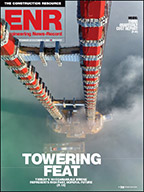Design Finalized for Messina Strait Bridge, World's Longest Suspension Plan


Italian government officials are reviewing final designs for an estimated $11.7-billion suspension bridge that, with a 3,330-meter-long main span, would break the current world-record length by 66%. Construction of the Messina Strait road-and-rail crossing between the mainland and Sicily could start next year, the owner's director general said at a London conference last month.
“The final design is fully confirmed … there are no [technical] uncertainties,” said Giuseppe Fiammenghi, director general of the owner, Stretto di Messina S.p.A., Rome, speaking at an engineering symposium. But he warned that financial uncertainties and Italy's economic situation could delay the project.
Government-owned Stretto di Messina has a concession to procure the crossing and then operate it for 30 years. In 2005, it awarded a turnkey contract to the Eurolink consortium led by Milan-based Impregilo S.p.A. Eurolink includes Japan's Ishigawajima-Harima Heavy Industries Co. Ltd., Tokyo, and Denmark's Cowi A/S, Lyngby, as its lead design firm.
In 2006, a new government scrapped the plan that had been promoted by outgoing Prime Minister Silvio Berlusconi. With Berlusconi's return to power in 2008, the project restarted.
The main-span length will surpass that of the current record-holder's, Japan's Akashi Kaikyo bridge, by 1,309 m. The 52-m-wide deck will include two 14-m-wide box girders for roadways and a 7.5-m-wide central railroad girder. The three decks will be linked at 30-m intervals with 4.5-m-deep, 3.75-m-wide cross box girders. The deck structure will be supported at 30-m intervals at its outer edges by hangers from pre-formed parallel wire-strand suspension cables. Rising about 380 m above concrete bases, two steel towers will have parallel legs linked with cross girders at their tops.
The bridge is designed to incur only minor damage during a seismic event with a 2,000-year return period, says Chris Scollard, project manager with Buckland & Taylor, a Cowi subsidiary. The deck includes hydraulic dampers to absorb seismic shocks. Coarse, granular soil up to 40 m beneath the piers will be jet-grouted to avoid liquefaction, adds Luigi Callisto, an associate professor at Rome University.
This summer, Stretto di Messina, with project manager Parsons Corp., approved Eurolink's design, now under review by the state's Interdepartmental Committee for Economic Planning. In a best-case scenario, work could start next summer, and the project could open in 2019.
Serious planning for the crossing began in 1969, says Fabio Brancaleoni, a civil engineering professor at Rome University and a Eurolink consultant. By 1986, tunnel options were eliminated. Deep water and difficult geology ruled out both a multispan, multipier option and a two-span option.
The single-span option remained. In the 1990s, the late William Brown, a U.K. engineer, proposed reducing wind-induced deck twisting by equalizing the air pressure on its top and bottom surfaces. That stability is achieved by separating the two roadways and railroad onto individual decks linked with cross girders.






